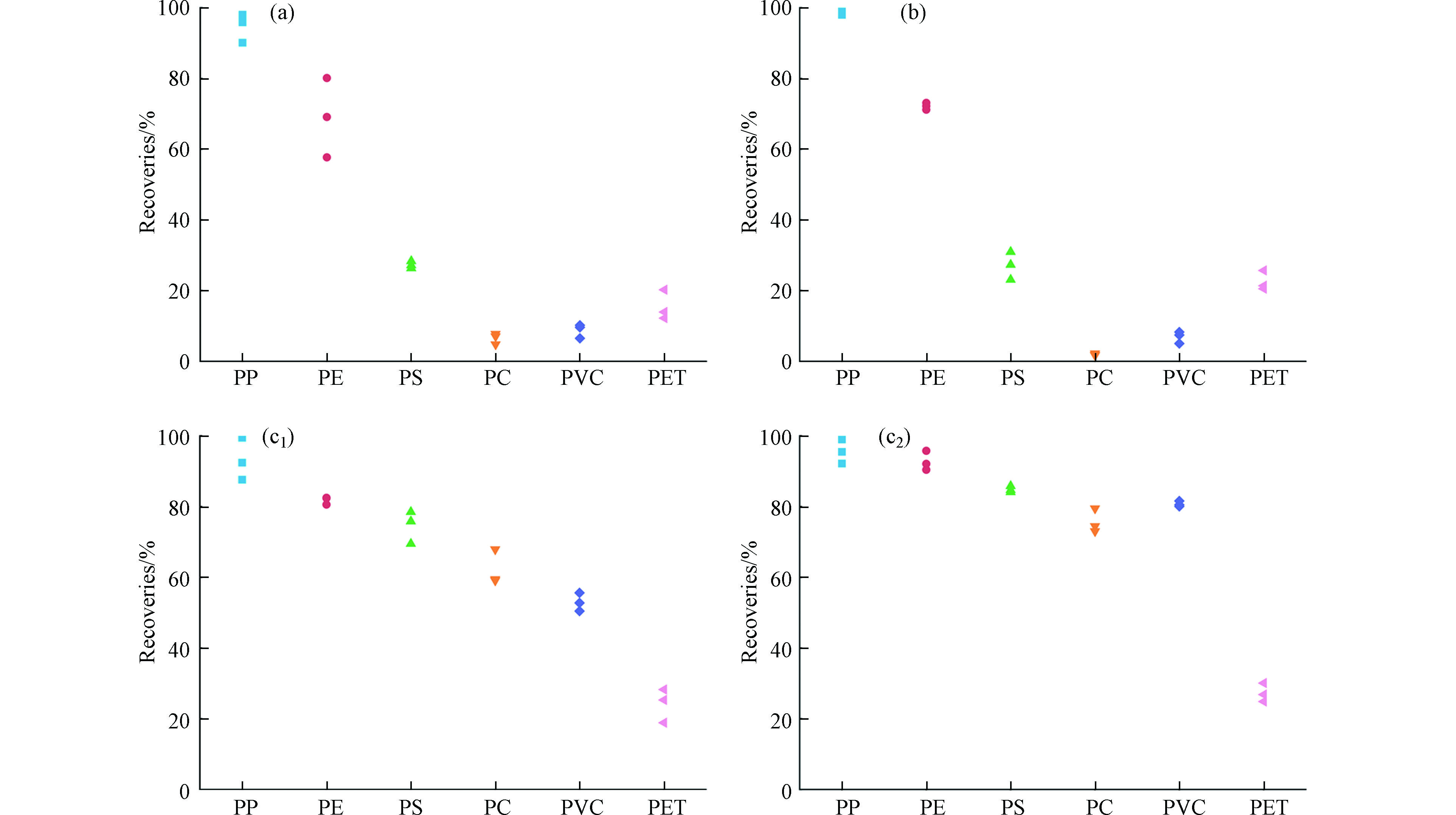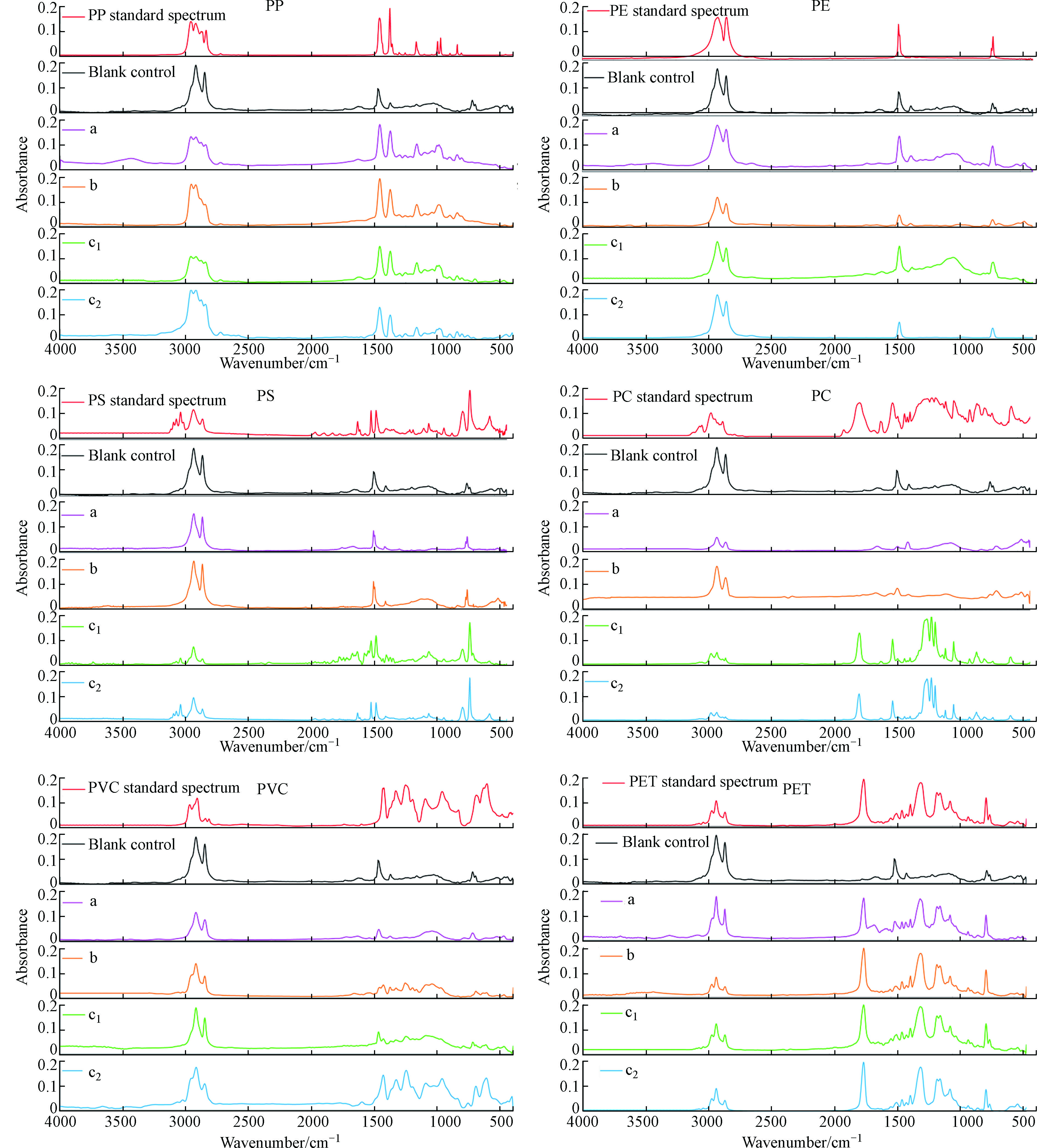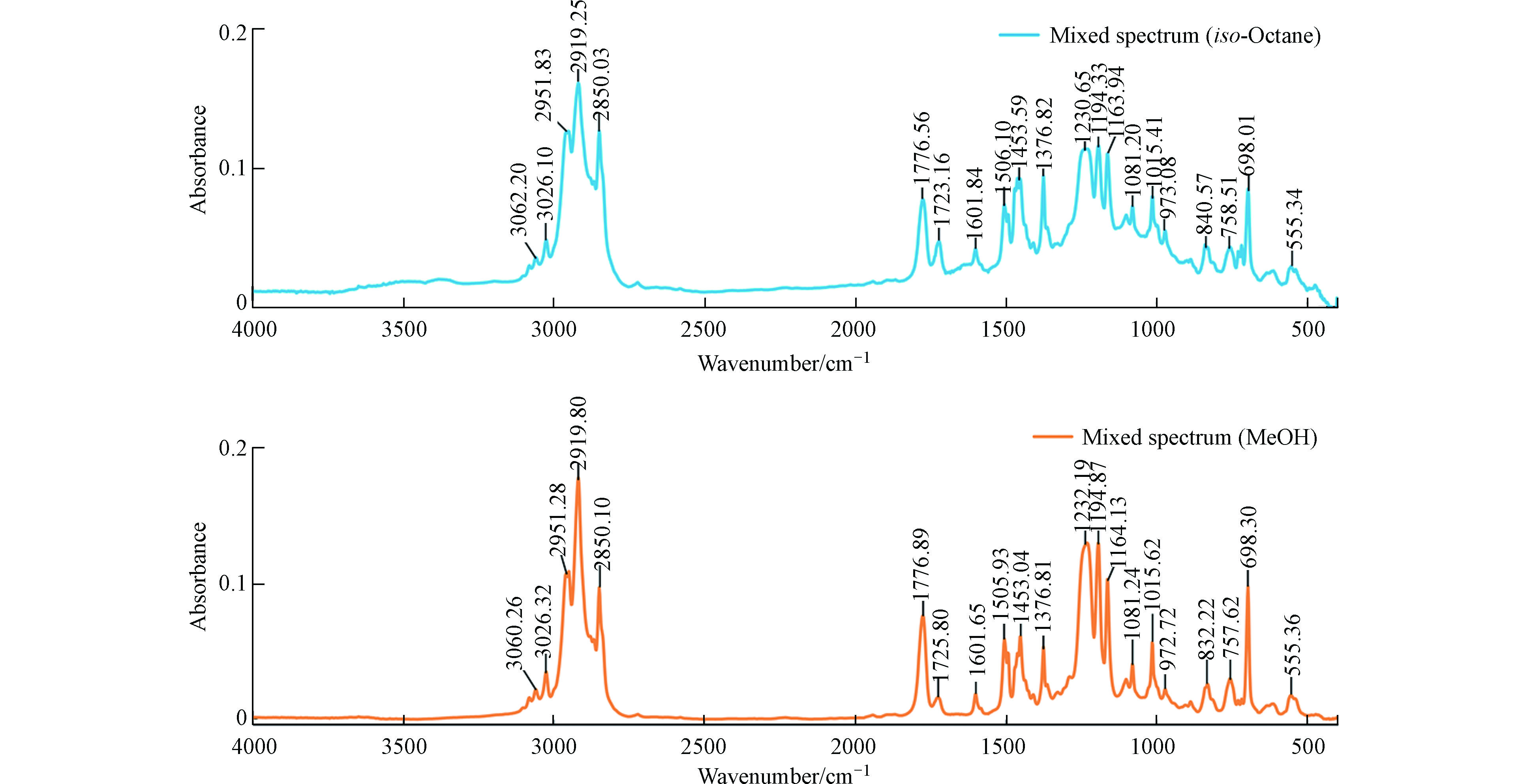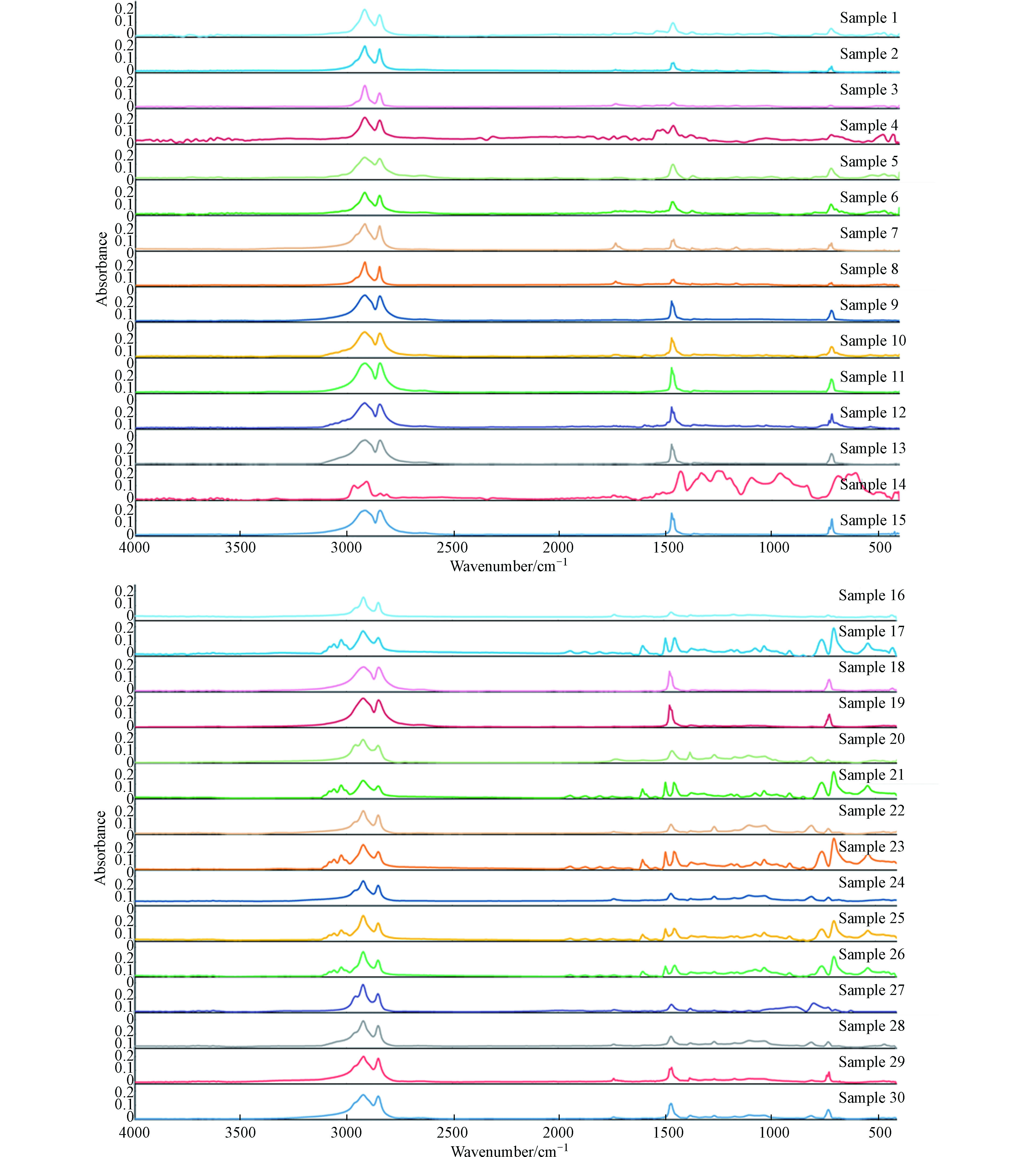-
微塑料(microplastics,MPs)被定义为尺寸小于5 mm的塑料颗粒、碎片或纤维[1],按照来源被分为初级微塑料和次级微塑料[2],初级微塑料主要是以微尺度制造的应用于化妆品等日用品行业[3-4],如个人洗护产品(磨砂膏、牙膏和洗面奶等)、化妆品(眼影、指甲油和粉底液等)、药物和树脂颗粒等[5]。次级微塑料是由大块塑料经过紫外线照射(光降解、脆化、光氧化)、风化和腐蚀等外界因素被分解成较小的塑料碎片[6]。近年来,微塑料对环境的污染越来越受到人们的关注,据报道,在海水[7-8]、淡水[9-10]、土壤[11]、室内灰尘[12]、空气[13]、人和动物粪便[14]以及人体胎盘[15]中都已经检测到微塑料。微塑料作为重要的新型污染物,其对人体、环境以及生态系统造成的潜在威胁应予以高度重视。
目前,提取沉积物中的微塑料通常采用密度分离法——使用饱和盐溶液(如NaCl或NaI溶液)将沉积物中的微塑料悬浮或漂浮于上层溶液,进一步从上清液中将微塑料分离出来[16],但该方法不适合分离粒径更小的塑料颗粒(<10 μm)[17],而且对于高密度微塑料来说,可能沉降于盐溶液底部,导致漏测现象发生。此外,还有研究根据微塑料的物理化学性质进行分离,例如使用油进行疏水性分离或利用尼罗红的吸附能力进行提取[18-19]。目前,多数文献报道中沉积物微塑料以数量浓度计算,主要反映微塑料的数量丰度,而质量浓度参数也是评估微塑料污染状况的重要指标之一。通过质量浓度测量,可反映微塑料在环境介质中的赋存量级,为微塑料环境污染状况进行整体评估及监测提供基础数据[20]。2017年,Connors等[21]指出微塑料暴露浓度以质量浓度(mg·L−1)表示可支持毒理学研究数据的一致性和可比性。Fuller等[22]开发了利用加压流体萃取(PFE)的方法对微塑料的质量浓度进行测量的分析方法,为了减少复杂介质中基质的干扰,在100 ℃下使用甲醇清洗,在180 ℃下用二氯甲烷(dichloromethane,DCM)提取微塑料,吹干后对残留物进行重量分析,并通过傅里叶变换红外光谱(FTIR)进行微塑料成分的鉴定。在实际样品分析中,利用甲醇预清洗可能会损失一部分微塑料,提取物中通常包含色素等其他有机杂质,对于方法的定性定量均可能产生干扰。本研究基于溶解—析出过程的特点,将溶解度参数(δ)作为指示性参数,可为微塑料质量浓度的检测提供新思路。
物质的溶解度参数被定义为:每单位体积物质的气化能的平方根,是一个能够表征简单液体分子间相互作用强度的参数值,用δ表示[23],公式如下:
其中,δ为溶解度参数,(J·cm−3)1/2;
ΔEv/V 是每单位体积物质的气化能,又叫内聚能,J·cm−3。通过计算聚合物的溶解度参数,并与溶剂的溶解度参数进行比较,可以对聚合物和溶剂之间的溶解程度进行量化表征。根据计算模型,聚合物和溶剂的溶解度参数越接近,则聚合物的溶解程度越高[24];反之,聚合物和溶剂的溶解度参数差异越大,则聚合物的溶解程度越低,在溶剂中越易析出。
本研究在加压流体萃取法(PFE)的基础上,建立了基于“溶解度参数”计算对沉积物中微塑料进行分析检测的新方法。通过将加压萃取得到的提取物进行浓缩,并根据溶解度参数计算结果,调整溶剂组成比例,选择与微塑料溶解度差异较大的溶剂体系进行微塑料选择性析出,将得到的提取物进行重量分析以及红外光谱检测,实现对沉积物中微塑料的定量定性分析。所建立的方法进一步通过对实际沉积物样品中的微塑料检测进行了验证。该方法可为土壤、沉积物以及室内灰尘等复杂介质中的微塑料测量提取提供新的思路。
-
仪器:ASE-350快速溶剂萃取仪(ASE)(Thermo,美国),IKA®RV10基本型旋转蒸发仪,溶剂过滤器(津腾)(附0.22 μm玻璃纤维过滤膜),傅里叶变换红外光谱仪(Nicolet iS10),XP205电子天平(瑞士 Mettler Toledo公司)。
试剂:二氯甲烷(dichloromethane,DCM)、甲醇(methanol,MeOH)、乙腈(acetonitrile,ACN)、异辛烷(iso-octane)和正己烷(n-Hexane)(HPLC级,99.9%,J.T.Baker公司),溴化钾(KBr,99.99%,金属分析,J&K®)。
标准品:聚丙烯(polypropylene,PP)、聚乙烯(polyethylene,PE)、聚苯乙烯(poly(styrene),PS)、聚碳酸酯(polycarbonate,PC)、聚氯乙烯(polyvinyl chloride,PVC)、聚对苯二甲酸乙二醇酯(polyethylene terephthalate,PET)。本实验所用的微塑料购买自上海远纺工业有限公司,其中PE微塑料d50约为20 μm,PET微塑料d50约为50 μm,其余4种微塑料d50均约为80 μm。
-
准确称取10.00 g冷冻干燥的沉积物样品加入ASE萃取池中,分别加入10.00 mg左右PP、PE、PS、PC、PVC和PET 等6种标准微塑料,加入与样品等体积的硅藻土混匀,按照如下条件进行加速溶剂萃取:萃取溶剂为二氯甲烷;温度180 ℃,压力1500 psi左右,淋洗体积为80%,加热9 min,3个静态循环,吹扫时间为75 s,静置时间为1 min。
为进一步验证溶解度参数对微塑料的选择性析出的影响,将收集得到的提取物分别采用3种不同的方式进行处理:(a)直接抽滤;(b)浓缩至10 mL左右;(c)浓缩至10 mL后调节体系溶解度参数:(c1)加入与微塑料溶解度参数不同的溶剂(其中,PP和PE中加入乙腈溶剂,PS、PC、PVC和PET中加入异辛烷溶剂)至100 mL;(c2)加入与微塑料溶解度参数差异更大的甲醇作为溶剂至100 mL,用溶剂过滤器进行抽滤。将滤膜烘干,称重,用傅里叶变换红外光谱仪(Nicolet iS10)进行成分鉴定,得到光谱图。具体提取和分析方法流程如图1所示。实验重复3次,共计72组实验。
为了扣除沉积物本底中微塑料的干扰,设置了平行对照组实验。将10.00 g沉积物和等体积的硅藻土混匀,按照上述实验步骤进行处理,得到本底中微塑料的质量及光谱图。
傅里叶变换红外光谱仪(Nicolet iS10)的检测器类型为DTGS/KBr,波数范围为400—4000 cm−1,样品扫描次数:32次,分辨率:4.00 cm−1。将图谱与标准品谱库(OMNIC谱库)进行比对,规定匹配度达70%及以上的谱图对应的样品为微塑料,以此确定微塑料的成分。
-
(1)采用基团贡献法对微塑料的溶解度参数进行计算[23],计算公式如下:
式中,ρ为聚合物的密度,M为聚合物链节的分子量,Fi为聚合物分子中各基团组分的摩尔引力常数。本研究6种微塑料的δ值参考已报道过的溶解度参数值[25],见表1。
(3)混合溶液的溶解度参数根据以下公式进行计算[23]:
式中,
ϕ i,δi为是第i组分溶剂的体积分数和溶解度参数,所有溶剂的体积分数之和∑ϕ i为1。经计算,得到混合溶剂的δ值见表3。 -
为了研究溶解度参数对微塑料选择性析出的影响,将收集得到的提取物采用如下方式进行处理:(a)直接抽滤,实验中发现只有PP和PE微塑料明显析出,这是由于DCM与PP和PE的溶解度参数存在差异,│Δδ│值分别为2.86、1.42(J·cm−3)1/2,导致PP和PE常温常压下在DCM中溶解度较小,而DCM与PS、PC、PVC和PET 等4种微塑料的溶解度参数较为接近,│Δδ│值分别为0.29、0.41、0.15、0.69(J·cm−3)1/2,因此未观察到明显析出;(b)采用旋转蒸发仪将提取液浓缩,通过减少溶剂的方式使微塑料析出,但实验中观察到浓缩至10 mL左右,微塑料并未明显析出,而由于溶解度的差异,提取液中的其他共萃物逐渐析出,表明浓缩的方式难以实现对微塑料的选择性析出;(c)为实现微塑料选择性析出,本研究进一步采用不同溶剂来调节体系的溶解度参数。针对PP和PE,选取乙腈进行添加,使溶剂体系溶解度参数与PP和PE的差值│Δδ│分别为6.87(J·cm−3)1/2和5.43(J·cm−3)1/2,针对PS、PC、PVC和PET,选取异辛烷进行添加,│Δδ│值分别为4.71、4.59、4.85、5.69(J·cm−3)1/2,得到的回收率如表4所示。
为了得到更加精确的回收率,本研究的回收率计算均通过平行试验扣除沉积物本底后进行计算。在3种不同的处理方式下,PP微塑料的回收率均高于93%,而通过计算发现,PP溶解度参数与DCM差异较大,因此常温常压下几乎完全析出。对于PET微塑料,在3种处理方式下,回收率均较低,均在30%以下。为了考察所建立方法的准确性,本研究设计两组加标实验进行验证:将PET微塑料标准品与硅藻土(模拟沉积物)混匀后经ASE提取:第一组将提取液经缓流氮气吹干,结果表明回收率在95%以上;第二组将提取液浓缩后加入甲醇,进行抽滤,回收率在85%以上。由此可见,PET微塑料在沉积物中的低回收率可能是由于沉积物环境引起的。有研究表明河流沉积物中的腐殖酸含有较多的羰基官能团[26],而PET微塑料的化学结构中存在两个羰基官能团,依据“相似相溶”原理,增强了PET在沉积物中的吸附效应,从而导致回收率较低。
由图2可以发现,直接抽滤(a)和浓缩处理(b)后的微塑料回收率无明显提升,而采用本研究所建立的溶解度参数计算结果对溶剂体系进行调整(c1)后,除PP和PET外,其他4种微塑料的回收率均有明显提高,表明增大溶剂体系溶解度参数与微塑料的差值│Δδ│对微塑料的选择性析出起到促进作用。
进一步采用添加与微塑料溶解度参数差异更大的甲醇调节溶剂体系的溶解度参数(c2),使溶剂体系溶解度参数与PP、PE、PS、PC、PVC和PET的差值│Δδ│分别达到11.88、10.44、9.31、9.43、9.17、8.33(J·cm−3)1/2,观察对6种微塑料析出的影响,得到的回收率如图2(c2)所示。通过图2中(c1)和(c2)结果对比发现,PE、PS、PC和PVC回收率均进一步提高,且得到的回收率均处于稳定的范围内,验证了│Δδ│值与微塑料析出量之间的相关性。
-
本研究中,6种微塑料在3种不同的处理方式下,由于所使用的试剂不同,选择性析出的组分会对微塑料成分鉴定造成不同的影响,鉴定结果如图3所示。由图3可以看出,在a、b、c1方式处理下,6种微塑料的红外光谱图与标准微塑料光谱相比,在指纹区(波段500—1500 cm−1)会存在杂峰干扰,在c2方式处理下,光谱图整体峰形与标准微塑料光谱图一致,匹配度较高。与谱库的匹配数据结果如表5所示。
由图3中PP和PE可知,在a、b、c1方式处理下,PP和PE微塑料在指纹区(波段500—1500 cm−1)波形明显上移,且存在杂峰干扰,表明在微塑料析出过程中,溶剂和沉积物中有机质的存在会对微塑料成分鉴定造成一定的影响,这是由于在FTIR检测过程中,微塑料样品孔隙间存在沉积物中的有机质等杂质,会影响光谱图质量。但从整体来看,在c2处理方式下得到的光谱图和标准微塑料光谱图匹配度较高。
由图3中PS可知,在a、b两种处理方式下,得到的光谱图经谱库检索,与PE光谱图匹配度达到90.11%和85.45%,这是由于PS的回收率较低,在30%以下,并且经过红外检测沉积物内存在PE微塑料本底,如图3中空白对照所示,导致光谱图特征峰被沉积物中的PE微塑料的光谱图所覆盖。c1处理方式下,PS光谱图在1796、1749、1714、1688、1641 cm−1处出现杂峰,与标准微塑料红外光谱图相比,存在一定的差异,经谱库检索,未得到匹配的聚合物。在c2处理方式下,光谱图与标准谱图匹配度较高。由图3中PC可知,在a、b两种处理方式下,由于PC微塑料回收率较低,经谱库检索,未得到匹配的聚合物。在c1和c2处理方式下,得到的光谱图与标准微塑料光谱图匹配度均较高。另外,由于原PC微塑料标准品的粒径相比于经过ASE萃取回收得到的微塑料粒径较大,使其在指纹区(500—1460 cm−1)的峰形分割不清晰,而经过萃取后,微塑料粒径变小且表面更加光滑、分布更加均匀,从而得到质量较好的光谱图。有研究表明红外谱仪检测时对样品的表面光滑度、厚度等要求较高,样品表面粗糙,易出现散射导致谱图信号变弱,从而对光谱图质量造成干扰[27]。
由图3中PVC可知,PVC微塑料在a、b、c1处理方式下,在指纹区(波段500—1500 cm−1)的峰形与原微塑料的红外光谱图相比存在明显差异,峰形不清晰,且多为杂峰,经谱库检索,在a处理方式下得到了PE的特征峰,而在b和c1处理方式下,得到的光谱图与PVC匹配度较低,无法判断聚合物类型。而在c2处理方式下,其红外光谱图与标准谱图匹配度较高。由图3 中PET可知,在a、b两种处理方式下,得到的光谱图经OMNIC谱库检索,未得到匹配的聚合物。在c1处理方式下,得到的光谱图与PET匹配度为69.06%,无法判断其聚合物类型。在c2处理方式下,得到的光谱图与原标准微塑料的红外光谱图匹配度较高。
综上所述,经ASE萃取得到的提取液经浓缩后添加与微塑料溶解度参数差异更大的甲醇溶剂能够使微塑料析出更加完全,且没有明显杂质干扰,得到的红外光谱图与标准谱图匹配度较高,可以实现对复杂介质中微塑料的选择性析出及检测。
-
为了更加全面地探究微塑料的析出情况,本研究进一步进行了混合微塑料加标实验:即称取10.00 g干燥的沉积物样品放入ASE萃取池中,加入各2.00 mg左右的6种微塑料,加入等体积的硅藻土混合均匀,按照1.2实验方法部分的步骤进行ASE萃取,得到的萃取物经旋蒸后分别按c1和c2的步骤进行处理。结果表明,经c1处理后,得到混合微塑料总回收率为77.94%,经c2处理后,混合微塑料总回收率为81.08%,得到的红外光谱图如图4所示。
由谱库可知,6种微塑料的红外标准谱图特征峰的出峰位置见表6。图4中混标的红外光谱图特征峰出现的位置在3085、3060、3026、2951、2919、2850、1776、1725、1601、1505、1453、1376、1232、1194、1164、1081、1015、972、832、758、698 cm−1等波数附近,与单标特征峰位置有重合,由此可以判断存在微塑料共析出的情况。结合红外光谱法的特征,在基于溶解度参数计算的前处理技术基础上,可对样品中具有标准谱图的微塑料成分进行初步定性,并可进一步采用Pry-GC-MS等技术对未知成分进行定性识别[28]。
-
应用建立的基于溶解度参数计算选择性析出微塑料的方法对采集自黄河三角洲地区的30个沉积物样品进行检测分析,样品量为30 g。表7总结了所采集的沉积物中微塑料浓度分布及类型。
图5为黄河三角洲沉积物中微塑料的红外光谱图。结果表明,共有4种微塑料被检出,分别为PE、PS、PP和PVC,检出率范围为3.33%—73.33%,其中,PE的检出率最高,其他3种微塑料的检出率均低于20%。有研究表明,渔业是沿海地区微塑料的主要来源[29],PE常用于包装和渔具等材料[5]。因此,渔业产生的塑料污染和河流引入可能是黄河三角洲地区沉积物中微塑料的主要来源。张起源[30]在湛江红树林湿地沉积物中开展的微塑料污染研究同样发现PE占比最高,该地区渔业养殖、河流引入以及海水中微塑料的沉积是微塑料的主要来源,与本研究结果基本一致。Zuo等[31]在珠江口红树林沉积物中发现PE和PP在各采样点中占比最高,由于PP常用于编织袋、包装袋等产品[32],从而导致PP在沉积物中的检出率同样较高。此外,本研究中微塑料浓度范围为0.04—0.39 mg·g−1,平均浓度为0.16 mg·g−1,远高于我国雨山湖和南湖沉积物中微塑料的平均含量(0.04 mg·g−1)[33],结合当地产业发展,应进一步开展对于该地区的微塑料污染监测。
-
本研究建立了基于溶解度参数计算的沉积物中微塑料的检测方法。通过调节溶剂体系的溶解度参数与微塑料的差值│Δδ│,实现了微塑料的选择性析出。结果表明,增大│Δδ│值对微塑料的选择性析出能起到促进作用。将本方法应用于黄河三角洲地区30个实际沉积物样品,共检出4种微塑料,进一步证实了本方法在实际样品分析检测中的可行性和实用价值。本研究为土壤、沉积物以及室内灰尘等复杂介质中微塑料的提取和分析提供了一种新的思路。
基于溶解度参数的计算检测沉积物中微塑料
Determination of microplastics in sediments based on solubility parameter calculation
-
摘要: 目前,密度分离法广泛应用于各种环境介质中微塑料的提取。为了进一步准确测量沉积物中微塑料的质量浓度,本研究开发了一种基于溶解度参数(δ)计算的选择性检测方法,建立了加速溶剂萃取(ASE)-微塑料选择性析出-傅里叶变换红外光谱仪(FTIR)检测的技术路线。6种微塑料[聚丙烯(PP)、聚乙烯(PE)、聚苯乙烯(PS)、聚碳酸酯(PC)、聚氯乙烯(PVC)和聚对苯二甲酸乙二醇酯(PET)]被添加到沉积物中,所得到的提取液分别通过3种方式进行预处理:(a)直接抽滤;(b)浓缩;(c)浓缩后调节溶剂体系溶解度参数。结果表明,微塑料的回收率均随着溶剂体系溶解度参数与微塑料的差值│Δδ│的增大有明显提高。此外,增大│Δδ│值对微塑料的选择性析出可明显去除FTIR检测过程中的干扰。将本方法应用于采集自黄河三角洲地区的30个实际沉积物样品的分析检测,共检出4种微塑料,其赋存特征与已有报道一致。本研究所建立的方法可为复杂环境固体基质中微塑料的精确测量提供技术支持。
-
关键词:
- 微塑料 /
- 溶解度参数 /
- 加速溶剂萃取(ASE) /
- 沉积物 /
- 傅里叶变换红外光谱(FTIR)
Abstract: Density separation method was widely used as a pretreatment procedure for microplastics analysis in various environmental matrices. To accurately measure the mass concentration of microplastics in sediment, a selective-purification procedure based on solubility parameter (δ) calculation was developed. The technical roadmap of accelerated solvent extraction (ASE)-selective precipitation of microplastics-Fourier Transform infrared spectroscopy(FTIR) analysis was established. Six types of microplastics [polypropylene (PP), polyethylene (PE), polystyrene (PS), polycarbonate (PC), polyvinyl chloride (PVC) and polyethylene terephthalate (PET)] were spiked into sediments for method development. The obtained extract was treated in three different ways: (a) direct filtration; (b) concentration; (c) adjust solubility parameters of the solvent system after concentration. The effect of three kinds of purification treatments was evaluated. The results indicated that the recoveries of microplastics increased obviously with the increase of │Δδ│ value between the solubility parameters of the solvent system and the microplastics. Besides, the interference of FTIR analysis could be removed obviously by increasing the │Δδ│ value for the selective precipitation of microplastics. The established method was successfully applied to the analysis of 30 sediment samples. Four kinds of microplastics were detected, and their occurrence characteristics were consistent with the previous reports. This work provided technical support to meet the need of accurate measurement of microplastics in complex environment solid matrices. -
微塑料(microplastics,MPs)被定义为尺寸小于5 mm的塑料颗粒、碎片或纤维[1],按照来源被分为初级微塑料和次级微塑料[2],初级微塑料主要是以微尺度制造的应用于化妆品等日用品行业[3-4],如个人洗护产品(磨砂膏、牙膏和洗面奶等)、化妆品(眼影、指甲油和粉底液等)、药物和树脂颗粒等[5]。次级微塑料是由大块塑料经过紫外线照射(光降解、脆化、光氧化)、风化和腐蚀等外界因素被分解成较小的塑料碎片[6]。近年来,微塑料对环境的污染越来越受到人们的关注,据报道,在海水[7-8]、淡水[9-10]、土壤[11]、室内灰尘[12]、空气[13]、人和动物粪便[14]以及人体胎盘[15]中都已经检测到微塑料。微塑料作为重要的新型污染物,其对人体、环境以及生态系统造成的潜在威胁应予以高度重视。
目前,提取沉积物中的微塑料通常采用密度分离法——使用饱和盐溶液(如NaCl或NaI溶液)将沉积物中的微塑料悬浮或漂浮于上层溶液,进一步从上清液中将微塑料分离出来[16],但该方法不适合分离粒径更小的塑料颗粒(<10 μm)[17],而且对于高密度微塑料来说,可能沉降于盐溶液底部,导致漏测现象发生。此外,还有研究根据微塑料的物理化学性质进行分离,例如使用油进行疏水性分离或利用尼罗红的吸附能力进行提取[18-19]。目前,多数文献报道中沉积物微塑料以数量浓度计算,主要反映微塑料的数量丰度,而质量浓度参数也是评估微塑料污染状况的重要指标之一。通过质量浓度测量,可反映微塑料在环境介质中的赋存量级,为微塑料环境污染状况进行整体评估及监测提供基础数据[20]。2017年,Connors等[21]指出微塑料暴露浓度以质量浓度(mg·L−1)表示可支持毒理学研究数据的一致性和可比性。Fuller等[22]开发了利用加压流体萃取(PFE)的方法对微塑料的质量浓度进行测量的分析方法,为了减少复杂介质中基质的干扰,在100 ℃下使用甲醇清洗,在180 ℃下用二氯甲烷(dichloromethane,DCM)提取微塑料,吹干后对残留物进行重量分析,并通过傅里叶变换红外光谱(FTIR)进行微塑料成分的鉴定。在实际样品分析中,利用甲醇预清洗可能会损失一部分微塑料,提取物中通常包含色素等其他有机杂质,对于方法的定性定量均可能产生干扰。本研究基于溶解—析出过程的特点,将溶解度参数(δ)作为指示性参数,可为微塑料质量浓度的检测提供新思路。
物质的溶解度参数被定义为:每单位体积物质的气化能的平方根,是一个能够表征简单液体分子间相互作用强度的参数值,用δ表示[23],公式如下:
δ=(ΔEv/V)1/2 (1) 其中,δ为溶解度参数,(J·cm−3)1/2;
ΔEv/V 通过计算聚合物的溶解度参数,并与溶剂的溶解度参数进行比较,可以对聚合物和溶剂之间的溶解程度进行量化表征。根据计算模型,聚合物和溶剂的溶解度参数越接近,则聚合物的溶解程度越高[24];反之,聚合物和溶剂的溶解度参数差异越大,则聚合物的溶解程度越低,在溶剂中越易析出。
本研究在加压流体萃取法(PFE)的基础上,建立了基于“溶解度参数”计算对沉积物中微塑料进行分析检测的新方法。通过将加压萃取得到的提取物进行浓缩,并根据溶解度参数计算结果,调整溶剂组成比例,选择与微塑料溶解度差异较大的溶剂体系进行微塑料选择性析出,将得到的提取物进行重量分析以及红外光谱检测,实现对沉积物中微塑料的定量定性分析。所建立的方法进一步通过对实际沉积物样品中的微塑料检测进行了验证。该方法可为土壤、沉积物以及室内灰尘等复杂介质中的微塑料测量提取提供新的思路。
1. 实验部分(Experimental section)
1.1 仪器与试剂
仪器:ASE-350快速溶剂萃取仪(ASE)(Thermo,美国),IKA®RV10基本型旋转蒸发仪,溶剂过滤器(津腾)(附0.22 μm玻璃纤维过滤膜),傅里叶变换红外光谱仪(Nicolet iS10),XP205电子天平(瑞士 Mettler Toledo公司)。
试剂:二氯甲烷(dichloromethane,DCM)、甲醇(methanol,MeOH)、乙腈(acetonitrile,ACN)、异辛烷(iso-octane)和正己烷(n-Hexane)(HPLC级,99.9%,J.T.Baker公司),溴化钾(KBr,99.99%,金属分析,J&K®)。
标准品:聚丙烯(polypropylene,PP)、聚乙烯(polyethylene,PE)、聚苯乙烯(poly(styrene),PS)、聚碳酸酯(polycarbonate,PC)、聚氯乙烯(polyvinyl chloride,PVC)、聚对苯二甲酸乙二醇酯(polyethylene terephthalate,PET)。本实验所用的微塑料购买自上海远纺工业有限公司,其中PE微塑料d50约为20 μm,PET微塑料d50约为50 μm,其余4种微塑料d50均约为80 μm。
1.2 实验方法
准确称取10.00 g冷冻干燥的沉积物样品加入ASE萃取池中,分别加入10.00 mg左右PP、PE、PS、PC、PVC和PET 等6种标准微塑料,加入与样品等体积的硅藻土混匀,按照如下条件进行加速溶剂萃取:萃取溶剂为二氯甲烷;温度180 ℃,压力1500 psi左右,淋洗体积为80%,加热9 min,3个静态循环,吹扫时间为75 s,静置时间为1 min。
为进一步验证溶解度参数对微塑料的选择性析出的影响,将收集得到的提取物分别采用3种不同的方式进行处理:(a)直接抽滤;(b)浓缩至10 mL左右;(c)浓缩至10 mL后调节体系溶解度参数:(c1)加入与微塑料溶解度参数不同的溶剂(其中,PP和PE中加入乙腈溶剂,PS、PC、PVC和PET中加入异辛烷溶剂)至100 mL;(c2)加入与微塑料溶解度参数差异更大的甲醇作为溶剂至100 mL,用溶剂过滤器进行抽滤。将滤膜烘干,称重,用傅里叶变换红外光谱仪(Nicolet iS10)进行成分鉴定,得到光谱图。具体提取和分析方法流程如图1所示。实验重复3次,共计72组实验。
为了扣除沉积物本底中微塑料的干扰,设置了平行对照组实验。将10.00 g沉积物和等体积的硅藻土混匀,按照上述实验步骤进行处理,得到本底中微塑料的质量及光谱图。
傅里叶变换红外光谱仪(Nicolet iS10)的检测器类型为DTGS/KBr,波数范围为400—4000 cm−1,样品扫描次数:32次,分辨率:4.00 cm−1。将图谱与标准品谱库(OMNIC谱库)进行比对,规定匹配度达70%及以上的谱图对应的样品为微塑料,以此确定微塑料的成分。
1.3 溶解度参数计算
(1)采用基团贡献法对微塑料的溶解度参数进行计算[23],计算公式如下:
δ=ρ∑Fi/M (2) 式中,ρ为聚合物的密度,M为聚合物链节的分子量,Fi为聚合物分子中各基团组分的摩尔引力常数。本研究6种微塑料的δ值参考已报道过的溶解度参数值[25],见表1。
表 1 6种微塑料的溶解度参数δ值Table 1. δ values of six microplastics微塑料 Microplastics 溶解度参数δ/(J·cm−3)1/2 PP 16.98 PE 18.42 PS 19.55 PC 19.43 PVC 19.69 PET 20.53 表 2 单一溶剂的溶解度参数δ值(298.15 K)Table 2. δ value of single solvent (298.15K)溶剂 Solvent 溶解度参数δ/(J·cm−3)1/2 二氯甲烷(DCM) 19.84 异辛烷(iso-octane) 14.29 乙腈(ACN) 24.29 甲醇(MeOH) 29.86 (3)混合溶液的溶解度参数根据以下公式进行计算[23]:
δmix=n∑i=1ϕiδi (3) 式中,
ϕ ϕ 表 3 混合溶剂的溶解度参数δ值(298.15 K)Table 3. δ value of mixed solvent (298.15K)混合溶剂( V ∶ V )Mixed solvent 溶解度参数δ/(J·cm−3)1/2 DCM∶iso-octane(10∶90) 14.85 DCM∶ACN(10∶90) 23.85 DCM∶MeOH(10∶90) 28.86 2. 结果与讨论(Results and discussion)
2.1 不同析出方法对沉积物中微塑料的回收率影响
为了研究溶解度参数对微塑料选择性析出的影响,将收集得到的提取物采用如下方式进行处理:(a)直接抽滤,实验中发现只有PP和PE微塑料明显析出,这是由于DCM与PP和PE的溶解度参数存在差异,│Δδ│值分别为2.86、1.42(J·cm−3)1/2,导致PP和PE常温常压下在DCM中溶解度较小,而DCM与PS、PC、PVC和PET 等4种微塑料的溶解度参数较为接近,│Δδ│值分别为0.29、0.41、0.15、0.69(J·cm−3)1/2,因此未观察到明显析出;(b)采用旋转蒸发仪将提取液浓缩,通过减少溶剂的方式使微塑料析出,但实验中观察到浓缩至10 mL左右,微塑料并未明显析出,而由于溶解度的差异,提取液中的其他共萃物逐渐析出,表明浓缩的方式难以实现对微塑料的选择性析出;(c)为实现微塑料选择性析出,本研究进一步采用不同溶剂来调节体系的溶解度参数。针对PP和PE,选取乙腈进行添加,使溶剂体系溶解度参数与PP和PE的差值│Δδ│分别为6.87(J·cm−3)1/2和5.43(J·cm−3)1/2,针对PS、PC、PVC和PET,选取异辛烷进行添加,│Δδ│值分别为4.71、4.59、4.85、5.69(J·cm−3)1/2,得到的回收率如表4所示。
为了得到更加精确的回收率,本研究的回收率计算均通过平行试验扣除沉积物本底后进行计算。在3种不同的处理方式下,PP微塑料的回收率均高于93%,而通过计算发现,PP溶解度参数与DCM差异较大,因此常温常压下几乎完全析出。对于PET微塑料,在3种处理方式下,回收率均较低,均在30%以下。为了考察所建立方法的准确性,本研究设计两组加标实验进行验证:将PET微塑料标准品与硅藻土(模拟沉积物)混匀后经ASE提取:第一组将提取液经缓流氮气吹干,结果表明回收率在95%以上;第二组将提取液浓缩后加入甲醇,进行抽滤,回收率在85%以上。由此可见,PET微塑料在沉积物中的低回收率可能是由于沉积物环境引起的。有研究表明河流沉积物中的腐殖酸含有较多的羰基官能团[26],而PET微塑料的化学结构中存在两个羰基官能团,依据“相似相溶”原理,增强了PET在沉积物中的吸附效应,从而导致回收率较低。
表 4 不同析出方法的加标回收率(%)及相对标准偏差RSD(%,n=3)Table 4. Spiked recoveries (%) and relative satandard deviation (RSD) (%, n=3) of different precipitation methods直接抽滤 浓缩 浓缩后调节溶剂体系Solvent system after concentration 微塑料Microplastics Direct filtration Direct filtration c1 c2 回收率Recoveries 相对标准偏差RSD 回收率Recoveries 相对标准偏差RSD 回收率Recoveries 相对标准偏差RSD 回收率Recoveries 相对标准偏差RSD PP 94.67 ± 4.10 4.33 98.54 ± 0.54 0.55 93.16 ± 5.95 6.39 95.55 ± 3.39 3.55 PE 68.98 ± 11.21 16.25 72.16 ± 0.94 1.31 81.82 ± 1.07 1.31 92.75 ± 2.74 2.95 PS 27.32 ± 1.01 3.70 27.14 ± 3.95 14.55 74.61 ± 4.64 6.21 84.88 ± 0.89 1.04 PC 6.56 ± 1.54 23.45 1.96 ± 0.29 15.03 62.17 ± 5.00 8.03 75.67 ± 3.37 4.46 PVC 8.80 ± 1.99 22.65 6.95 ± 1.68 24.16 52.96 ± 2.58 4.87 80.75 ± 0.78 0.97 PET 15.49 ± 4.21 27.15 22.56 ± 2.75 12.20 24.16 ± 4.79 19.82 27.28 ± 2.63 9.63 (c1) PP、PE微塑料用乙腈析出,PS、PC、PVC、PET4种微塑料用异辛烷析出; (c2) 6种微塑料用甲醇析出。 (c1) PP and PE microplastics were precipitated with acetonitrile, PS, PC, PVC and PET microplastics were precipitated with isooctane; (c2) 6 microplastics were precipitated with methanol. 由图2可以发现,直接抽滤(a)和浓缩处理(b)后的微塑料回收率无明显提升,而采用本研究所建立的溶解度参数计算结果对溶剂体系进行调整(c1)后,除PP和PET外,其他4种微塑料的回收率均有明显提高,表明增大溶剂体系溶解度参数与微塑料的差值│Δδ│对微塑料的选择性析出起到促进作用。
 图 2 不同处理方式下沉积物中微塑料的回收率Figure 2. Recoveries of microplastics in sediments under different treatment methods(a) 直接抽滤;(b)浓缩;(c1)PP、PE微塑料用乙腈析出,PS、PC、PVC、PET 4种微塑料用异辛烷析出;(c2)6种微塑料用甲醇析出。(a) direct filtration; (b) concentration;(c1)PP and PE microplastics were precipitated with acetonitrile, PS, PC, PVC and PET microplastics were precipitated with isooctane; (c2) 6 microplastics were precipitated with methanol.
图 2 不同处理方式下沉积物中微塑料的回收率Figure 2. Recoveries of microplastics in sediments under different treatment methods(a) 直接抽滤;(b)浓缩;(c1)PP、PE微塑料用乙腈析出,PS、PC、PVC、PET 4种微塑料用异辛烷析出;(c2)6种微塑料用甲醇析出。(a) direct filtration; (b) concentration;(c1)PP and PE microplastics were precipitated with acetonitrile, PS, PC, PVC and PET microplastics were precipitated with isooctane; (c2) 6 microplastics were precipitated with methanol.进一步采用添加与微塑料溶解度参数差异更大的甲醇调节溶剂体系的溶解度参数(c2),使溶剂体系溶解度参数与PP、PE、PS、PC、PVC和PET的差值│Δδ│分别达到11.88、10.44、9.31、9.43、9.17、8.33(J·cm−3)1/2,观察对6种微塑料析出的影响,得到的回收率如图2(c2)所示。通过图2中(c1)和(c2)结果对比发现,PE、PS、PC和PVC回收率均进一步提高,且得到的回收率均处于稳定的范围内,验证了│Δδ│值与微塑料析出量之间的相关性。
2.2 不同析出方法对微塑料成分鉴定的影响
本研究中,6种微塑料在3种不同的处理方式下,由于所使用的试剂不同,选择性析出的组分会对微塑料成分鉴定造成不同的影响,鉴定结果如图3所示。由图3可以看出,在a、b、c1方式处理下,6种微塑料的红外光谱图与标准微塑料光谱相比,在指纹区(波段500—1500 cm−1)会存在杂峰干扰,在c2方式处理下,光谱图整体峰形与标准微塑料光谱图一致,匹配度较高。与谱库的匹配数据结果如表5所示。
表 5 不同处理方式下沉积物中6种微塑料的鉴定结果Table 5. Identification results of 6 microplastics in sediments under different treatment methods加标聚合物Spiked polymers 不同处理方式 Different treatment methods 聚合物识别 Polymers identified OMNIC 匹配度/% OMNIC Match PP a PP 83.43 b PP 85.42 c1 PP 84.67 c2 PP 90.53 PE a PE 87.30 b PE 88.83 c1 PE 79.76 c2 PE 89.92 PS a PE 90.11 b PE 85.45 c1 ND - c2 PS 93.19 PC a ND - b ND - c1 PC 94.83 c2 PC 97.22 PVC a PE 81.85 b PVC 68.07 c1 PVC 69.04 c2 PVC 86.29 PET a ND - b ND - c1 PET 69.06 c2 PET 89.98 ND.,未检出。not detected. 由图3中PP和PE可知,在a、b、c1方式处理下,PP和PE微塑料在指纹区(波段500—1500 cm−1)波形明显上移,且存在杂峰干扰,表明在微塑料析出过程中,溶剂和沉积物中有机质的存在会对微塑料成分鉴定造成一定的影响,这是由于在FTIR检测过程中,微塑料样品孔隙间存在沉积物中的有机质等杂质,会影响光谱图质量。但从整体来看,在c2处理方式下得到的光谱图和标准微塑料光谱图匹配度较高。
 图 3 不同处理方式下沉积物中6种微塑料的红外光谱图Figure 3. FTIR spectra of microplastics in sediments under different treatment methods(a)直接抽滤;(b)浓缩;(c1)PP、PE微塑料用乙腈析出,PS、PC、PVC、PET等4种微塑料用异辛烷析出;(c2)6种微塑料用甲醇析出。(a) direct filtration; (b) concentration;(c1)PP and PE microplastics were precipitated with acetonitrile, PS, PC, PVC and PET microplastics were precipitated with isooctane; (c2) 6 microplastics were precipitated with methanol.
图 3 不同处理方式下沉积物中6种微塑料的红外光谱图Figure 3. FTIR spectra of microplastics in sediments under different treatment methods(a)直接抽滤;(b)浓缩;(c1)PP、PE微塑料用乙腈析出,PS、PC、PVC、PET等4种微塑料用异辛烷析出;(c2)6种微塑料用甲醇析出。(a) direct filtration; (b) concentration;(c1)PP and PE microplastics were precipitated with acetonitrile, PS, PC, PVC and PET microplastics were precipitated with isooctane; (c2) 6 microplastics were precipitated with methanol.由图3中PS可知,在a、b两种处理方式下,得到的光谱图经谱库检索,与PE光谱图匹配度达到90.11%和85.45%,这是由于PS的回收率较低,在30%以下,并且经过红外检测沉积物内存在PE微塑料本底,如图3中空白对照所示,导致光谱图特征峰被沉积物中的PE微塑料的光谱图所覆盖。c1处理方式下,PS光谱图在1796、1749、1714、1688、1641 cm−1处出现杂峰,与标准微塑料红外光谱图相比,存在一定的差异,经谱库检索,未得到匹配的聚合物。在c2处理方式下,光谱图与标准谱图匹配度较高。由图3中PC可知,在a、b两种处理方式下,由于PC微塑料回收率较低,经谱库检索,未得到匹配的聚合物。在c1和c2处理方式下,得到的光谱图与标准微塑料光谱图匹配度均较高。另外,由于原PC微塑料标准品的粒径相比于经过ASE萃取回收得到的微塑料粒径较大,使其在指纹区(500—1460 cm−1)的峰形分割不清晰,而经过萃取后,微塑料粒径变小且表面更加光滑、分布更加均匀,从而得到质量较好的光谱图。有研究表明红外谱仪检测时对样品的表面光滑度、厚度等要求较高,样品表面粗糙,易出现散射导致谱图信号变弱,从而对光谱图质量造成干扰[27]。
由图3中PVC可知,PVC微塑料在a、b、c1处理方式下,在指纹区(波段500—1500 cm−1)的峰形与原微塑料的红外光谱图相比存在明显差异,峰形不清晰,且多为杂峰,经谱库检索,在a处理方式下得到了PE的特征峰,而在b和c1处理方式下,得到的光谱图与PVC匹配度较低,无法判断聚合物类型。而在c2处理方式下,其红外光谱图与标准谱图匹配度较高。由图3 中PET可知,在a、b两种处理方式下,得到的光谱图经OMNIC谱库检索,未得到匹配的聚合物。在c1处理方式下,得到的光谱图与PET匹配度为69.06%,无法判断其聚合物类型。在c2处理方式下,得到的光谱图与原标准微塑料的红外光谱图匹配度较高。
综上所述,经ASE萃取得到的提取液经浓缩后添加与微塑料溶解度参数差异更大的甲醇溶剂能够使微塑料析出更加完全,且没有明显杂质干扰,得到的红外光谱图与标准谱图匹配度较高,可以实现对复杂介质中微塑料的选择性析出及检测。
2.3 混合微塑料共析出
为了更加全面地探究微塑料的析出情况,本研究进一步进行了混合微塑料加标实验:即称取10.00 g干燥的沉积物样品放入ASE萃取池中,加入各2.00 mg左右的6种微塑料,加入等体积的硅藻土混合均匀,按照1.2实验方法部分的步骤进行ASE萃取,得到的萃取物经旋蒸后分别按c1和c2的步骤进行处理。结果表明,经c1处理后,得到混合微塑料总回收率为77.94%,经c2处理后,混合微塑料总回收率为81.08%,得到的红外光谱图如图4所示。
由谱库可知,6种微塑料的红外标准谱图特征峰的出峰位置见表6。图4中混标的红外光谱图特征峰出现的位置在3085、3060、3026、2951、2919、2850、1776、1725、1601、1505、1453、1376、1232、1194、1164、1081、1015、972、832、758、698 cm−1等波数附近,与单标特征峰位置有重合,由此可以判断存在微塑料共析出的情况。结合红外光谱法的特征,在基于溶解度参数计算的前处理技术基础上,可对样品中具有标准谱图的微塑料成分进行初步定性,并可进一步采用Pry-GC-MS等技术对未知成分进行定性识别[28]。
表 6 微塑料的红外标准谱图特征峰位置Table 6. Position of characteristic peak of FTIR standard spectrum of microplastics塑料类型 红外标准谱图特征峰位置/cm−1 PP 2958、2919、1457、1374、1163、986 PE 2920、2848、1466、721 PS 3082、3060、3026、2920、2850、1601、1452、1375、1181、1028、906、756 PC 2967、2920、2850、1774、1601、1505、1464、1409、1365、1228、1193、1163、1103、1081、1015、831、769 PVC 2920、2850、1431、1330、1247、1093、964、695 PET 2920、2850、1725、1457、1411、1258、1105、1023、729 2.4 实际样品应用
应用建立的基于溶解度参数计算选择性析出微塑料的方法对采集自黄河三角洲地区的30个沉积物样品进行检测分析,样品量为30 g。表7总结了所采集的沉积物中微塑料浓度分布及类型。
表 7 黄河三角洲沉积物中微塑料浓度分布及类型Table 7. concentrations and types of microplastics in sediments of Yellow River Delta样品Samples 浓度/(mg·g−1)Concentration 微塑料类型Microplastic types 样品Samples 浓度/(mg·g−1)Concentration 微塑料类型Microplastic types 1 0.04 PE 16 0.11 PE 2 0.14 PE 17 0.21 PS 3 0.05 PE 18 0.16 PE 4 0.19 PE 19 0.15 PE 5 0.08 PE 20 0.16 PP 6 0.08 PE 21 0.26 PS 7 0.15 PE 22 0.13 PE 8 0.07 PE 23 0.17 PS 9 0.08 PE 24 0.09 PE 10 0.39 PE 25 0.16 PS 11 0.25 PE 26 0.10 PS 12 0.25 PE 27 0.11 PP 13 0.23 PE 28 0.10 PE 14 0.15 PVC 29 0.27 PE 15 0.17 PE 30 0.25 PE 图5为黄河三角洲沉积物中微塑料的红外光谱图。结果表明,共有4种微塑料被检出,分别为PE、PS、PP和PVC,检出率范围为3.33%—73.33%,其中,PE的检出率最高,其他3种微塑料的检出率均低于20%。有研究表明,渔业是沿海地区微塑料的主要来源[29],PE常用于包装和渔具等材料[5]。因此,渔业产生的塑料污染和河流引入可能是黄河三角洲地区沉积物中微塑料的主要来源。张起源[30]在湛江红树林湿地沉积物中开展的微塑料污染研究同样发现PE占比最高,该地区渔业养殖、河流引入以及海水中微塑料的沉积是微塑料的主要来源,与本研究结果基本一致。Zuo等[31]在珠江口红树林沉积物中发现PE和PP在各采样点中占比最高,由于PP常用于编织袋、包装袋等产品[32],从而导致PP在沉积物中的检出率同样较高。此外,本研究中微塑料浓度范围为0.04—0.39 mg·g−1,平均浓度为0.16 mg·g−1,远高于我国雨山湖和南湖沉积物中微塑料的平均含量(0.04 mg·g−1)[33],结合当地产业发展,应进一步开展对于该地区的微塑料污染监测。
3. 结论(Conclusion)
本研究建立了基于溶解度参数计算的沉积物中微塑料的检测方法。通过调节溶剂体系的溶解度参数与微塑料的差值│Δδ│,实现了微塑料的选择性析出。结果表明,增大│Δδ│值对微塑料的选择性析出能起到促进作用。将本方法应用于黄河三角洲地区30个实际沉积物样品,共检出4种微塑料,进一步证实了本方法在实际样品分析检测中的可行性和实用价值。本研究为土壤、沉积物以及室内灰尘等复杂介质中微塑料的提取和分析提供了一种新的思路。
-
表 1 6种微塑料的溶解度参数δ值
Table 1. δ values of six microplastics
微塑料 Microplastics 溶解度参数δ/(J·cm−3)1/2 PP 16.98 PE 18.42 PS 19.55 PC 19.43 PVC 19.69 PET 20.53 表 2 单一溶剂的溶解度参数δ值(298.15 K)
Table 2. δ value of single solvent (298.15K)
溶剂 Solvent 溶解度参数δ/(J·cm−3)1/2 二氯甲烷(DCM) 19.84 异辛烷(iso-octane) 14.29 乙腈(ACN) 24.29 甲醇(MeOH) 29.86 表 3 混合溶剂的溶解度参数δ值(298.15 K)
Table 3. δ value of mixed solvent (298.15K)
混合溶剂( V ∶ V )Mixed solvent 溶解度参数δ/(J·cm−3)1/2 DCM∶iso-octane(10∶90) 14.85 DCM∶ACN(10∶90) 23.85 DCM∶MeOH(10∶90) 28.86 表 4 不同析出方法的加标回收率(%)及相对标准偏差RSD(%,n=3)
Table 4. Spiked recoveries (%) and relative satandard deviation (RSD) (%, n=3) of different precipitation methods
直接抽滤 浓缩 浓缩后调节溶剂体系Solvent system after concentration 微塑料Microplastics Direct filtration Direct filtration c1 c2 回收率Recoveries 相对标准偏差RSD 回收率Recoveries 相对标准偏差RSD 回收率Recoveries 相对标准偏差RSD 回收率Recoveries 相对标准偏差RSD PP 94.67 ± 4.10 4.33 98.54 ± 0.54 0.55 93.16 ± 5.95 6.39 95.55 ± 3.39 3.55 PE 68.98 ± 11.21 16.25 72.16 ± 0.94 1.31 81.82 ± 1.07 1.31 92.75 ± 2.74 2.95 PS 27.32 ± 1.01 3.70 27.14 ± 3.95 14.55 74.61 ± 4.64 6.21 84.88 ± 0.89 1.04 PC 6.56 ± 1.54 23.45 1.96 ± 0.29 15.03 62.17 ± 5.00 8.03 75.67 ± 3.37 4.46 PVC 8.80 ± 1.99 22.65 6.95 ± 1.68 24.16 52.96 ± 2.58 4.87 80.75 ± 0.78 0.97 PET 15.49 ± 4.21 27.15 22.56 ± 2.75 12.20 24.16 ± 4.79 19.82 27.28 ± 2.63 9.63 (c1) PP、PE微塑料用乙腈析出,PS、PC、PVC、PET4种微塑料用异辛烷析出; (c2) 6种微塑料用甲醇析出。 (c1) PP and PE microplastics were precipitated with acetonitrile, PS, PC, PVC and PET microplastics were precipitated with isooctane; (c2) 6 microplastics were precipitated with methanol. 表 5 不同处理方式下沉积物中6种微塑料的鉴定结果
Table 5. Identification results of 6 microplastics in sediments under different treatment methods
加标聚合物Spiked polymers 不同处理方式 Different treatment methods 聚合物识别 Polymers identified OMNIC 匹配度/% OMNIC Match PP a PP 83.43 b PP 85.42 c1 PP 84.67 c2 PP 90.53 PE a PE 87.30 b PE 88.83 c1 PE 79.76 c2 PE 89.92 PS a PE 90.11 b PE 85.45 c1 ND - c2 PS 93.19 PC a ND - b ND - c1 PC 94.83 c2 PC 97.22 PVC a PE 81.85 b PVC 68.07 c1 PVC 69.04 c2 PVC 86.29 PET a ND - b ND - c1 PET 69.06 c2 PET 89.98 ND.,未检出。not detected. 表 6 微塑料的红外标准谱图特征峰位置
Table 6. Position of characteristic peak of FTIR standard spectrum of microplastics
塑料类型 红外标准谱图特征峰位置/cm−1 PP 2958、2919、1457、1374、1163、986 PE 2920、2848、1466、721 PS 3082、3060、3026、2920、2850、1601、1452、1375、1181、1028、906、756 PC 2967、2920、2850、1774、1601、1505、1464、1409、1365、1228、1193、1163、1103、1081、1015、831、769 PVC 2920、2850、1431、1330、1247、1093、964、695 PET 2920、2850、1725、1457、1411、1258、1105、1023、729 表 7 黄河三角洲沉积物中微塑料浓度分布及类型
Table 7. concentrations and types of microplastics in sediments of Yellow River Delta
样品Samples 浓度/(mg·g−1)Concentration 微塑料类型Microplastic types 样品Samples 浓度/(mg·g−1)Concentration 微塑料类型Microplastic types 1 0.04 PE 16 0.11 PE 2 0.14 PE 17 0.21 PS 3 0.05 PE 18 0.16 PE 4 0.19 PE 19 0.15 PE 5 0.08 PE 20 0.16 PP 6 0.08 PE 21 0.26 PS 7 0.15 PE 22 0.13 PE 8 0.07 PE 23 0.17 PS 9 0.08 PE 24 0.09 PE 10 0.39 PE 25 0.16 PS 11 0.25 PE 26 0.10 PS 12 0.25 PE 27 0.11 PP 13 0.23 PE 28 0.10 PE 14 0.15 PVC 29 0.27 PE 15 0.17 PE 30 0.25 PE -
[1] de SOUZA MACHADO A A, KLOAS W, ZARFL C, et al. Microplastics as an emerging threat to terrestrial ecosystems [J]. Global Change Biology, 2018, 24(4): 1405-1416. doi: 10.1111/gcb.14020 [2] GÜVEN O, GÖKDAĞ K, JOVANOVIĆ B, et al. Microplastic litter composition of the Turkish territorial waters of the Mediterranean Sea, and its occurrence in the gastrointestinal tract of fish [J]. Environmental Pollution, 2017, 223: 286-294. doi: 10.1016/j.envpol.2017.01.025 [3] 邹艳琴, 李钟瑞. 个人护理品和化妆品中塑料微珠的危害与法规要求 [J]. 日用化学品科学, 2015, 38(10): 1-4. ZOU Y Q, LI Z R. Hazardous properties of microbeads and regulatory requirements in personal care and cosmetic products [J]. Detergent & Cosmetics, 2015, 38(10): 1-4(in Chinese).
[4] FENDALL L S, SEWELL M A. Contributing to marine pollution by washing your face: Microplastics in facial cleansers [J]. Marine Pollution Bulletin, 2009, 58(8): 1225-1228. doi: 10.1016/j.marpolbul.2009.04.025 [5] CAI M G, HE H X, LIU M Y, et al. Lost but can't be neglected: Huge quantities of small microplastics hide in the South China Sea [J]. Science of the Total Environment, 2018, 633: 1206-1216. doi: 10.1016/j.scitotenv.2018.03.197 [6] ENGLER R E. The complex interaction between marine debris and toxic chemicals in the ocean [J]. Environmental Science & Technology, 2012, 46(22): 12302-12315. [7] MU J L, QU L, JIN F, et al. Abundance and distribution of microplastics in the surface sediments from the northern Bering and Chukchi Seas [J]. Environmental Pollution, 2019, 245: 122-130. doi: 10.1016/j.envpol.2018.10.097 [8] ZHANG C F, ZHOU H H, CUI Y Z, et al. Microplastics in offshore sediment in the Yellow Sea and East China sea, China [J]. Environmental Pollution, 2019, 244: 827-833. doi: 10.1016/j.envpol.2018.10.102 [9] WEN X F, DU C Y, XU P, et al. Microplastic pollution in surface sediments of urban water areas in Changsha, China: Abundance, composition, surface textures [J]. Marine Pollution Bulletin, 2018, 136: 414-423. doi: 10.1016/j.marpolbul.2018.09.043 [10] JIAN M F, ZHANG Y, YANG W J, et al. Occurrence and distribution of microplastics in China's largest freshwater lake system [J]. Chemosphere, 2020, 261: 128186. doi: 10.1016/j.chemosphere.2020.128186 [11] 韩丽花, 徐笠, 李巧玲, 等. 辽河流域土壤中微(中)塑料的丰度、特征及潜在来源 [J]. 环境科学, 2021, 42(4): 1781-1790. HAN L H, XU L, LI Q L, et al. Levels, characteristics, and potential source of micro (meso) plastic pollution of soil in Liaohe River Basin [J]. Environmental Science, 2021, 42(4): 1781-1790(in Chinese).
[12] ZHANG J J, WANG L, KANNAN K. Microplastics in house dust from 12 countries and associated human exposure [J]. Environment International, 2020, 134: 105314. doi: 10.1016/j.envint.2019.105314 [13] 周倩, 田崇国, 骆永明. 滨海城市大气环境中发现多种微塑料及其沉降通量差异 [J]. 科学通报, 2017, 62(33): 3902-3909. doi: 10.1360/N972017-00956 ZHOU Q, TIAN C G, LUO Y M. Various forms and deposition fluxes of microplastics identified in the coastal urban atmosphere [J]. Chinese Science Bulletin, 2017, 62(33): 3902-3909(in Chinese). doi: 10.1360/N972017-00956
[14] YAN Z H, ZHAO H J, ZHAO Y P, et al. An efficient method for extracting microplastics from feces of different species [J]. Journal of Hazardous Materials, 2020, 384: 121489. doi: 10.1016/j.jhazmat.2019.121489 [15] RAGUSA A, SVELATO A, SANTACROCE C, et al. Plasticenta: First evidence of microplastics in human placenta [J]. Environment International, 2021, 146: 106274. doi: 10.1016/j.envint.2020.106274 [16] 王昆, 林坤德, 袁东星. 环境样品中微塑料的分析方法研究进展 [J]. 环境化学, 2017, 36(1): 27-36. doi: 10.7524/j.issn.0254-6108.2017.01.2016051704 WANG K, LIN K D, YUAN D X. Research progress on the analysis of microplastics in the environment [J]. Environmental Chemistry, 2017, 36(1): 27-36(in Chinese). doi: 10.7524/j.issn.0254-6108.2017.01.2016051704
[17] CLAESSENS M, van CAUWENBERGHE L, VANDEGEHUCHTE M B, et al. New techniques for the detection of microplastics in sediments and field collected organisms [J]. Marine Pollution Bulletin, 2013, 70(1/2): 227-233. [18] CRICHTON E M, NOËL M, GIES E A, et al. A novel, density-independent and FTIR-compatible approach for the rapid extraction of microplastics from aquatic sediments [J]. Analytical Methods, 2017, 9(9): 1419-1428. doi: 10.1039/C6AY02733D [19] DEVRIESE L I, van der MEULEN M D, MAES T, et al. Microplastic contamination in brown shrimp (Crangon crangon, Linnaeus 1758) from coastal waters of the Southern North Sea and Channel area [J]. Marine Pollution Bulletin, 2015, 98(1/2): 179-187. [20] STUBBINS A, LAW K L, MUÑOZ S E, et al. Plastics in the Earth system [J]. Science, 2021, 373(6550): 51-55. doi: 10.1126/science.abb0354 [21] CONNORS K A, DYER S D, BELANGER S E. Advancing the quality of environmental microplastic research [J]. Environmental Toxicology and Chemistry, 2017, 36(7): 1697-1703. doi: 10.1002/etc.3829 [22] FULLER S, GAUTAM A. A procedure for measuring microplastics using pressurized fluid extraction [J]. Environmental Science & Technology, 2016, 50(11): 5774-5780. [23] 周效全. 物质溶解度参数的计算方法 [J]. 石油钻采工艺, 1991, 13(3): 63-70. ZHOU X Q. Calculation method of material solubility parameters [J]. Oil Drilling & Production Technology, 1991, 13(3): 63-70(in Chinese).
[24] 徐云蕾, 俞春芳, 黑恩成, 等. 液体内压的预测和新溶解度参数值 [J]. 化工学报, 2000, 51(3): 407-413. doi: 10.3321/j.issn:0438-1157.2000.03.023 XU Y L, YU C F, HEI E C, et al. Prediction of internal pressure and values of new solubility parameter for liquids [J]. Journal of Chemical Industry and Engineering (China), 2000, 51(3): 407-413(in Chinese). doi: 10.3321/j.issn:0438-1157.2000.03.023
[25] PENG Z J, SHAO M W, YU M, et al. Calculation and experimental validation of a novel approach using solubility parameters as indicators for the extraction of additives in plastics[J]. Analytical Chemistry, 2021,https://doi.org/10.1021/acs.analchem.1c03731. [26] 宋海燕, 尹友谊, 宋建中. 不同来源腐殖酸的化学组成与结构研究 [J]. 华南师范大学学报(自然科学版), 2009, 41(1): 61-66. SONG H Y, YIN Y Y, SONG J Z. The chemical composition and structure of humic acids from different environments [J]. Journal of South China Normal University (Natural Science Edition), 2009, 41(1): 61-66(in Chinese).
[27] 汤庆峰, 李琴梅, 王佳敏, 等. 显微-傅里叶变换红外光谱鉴别分析微塑料 [J]. 中国塑料, 2021, 35(8): 172-180. TANG Q F, LI Q M, WANG J M, et al. Identification and analysis of microplastics by micro Fourier transform infrared spectroscopy [J]. China Plastics, 2021, 35(8): 172-180(in Chinese).
[28] FISCHER M, SCHOLZ-BÖTTCHER B M. Simultaneous trace identification and quantification of common types of microplastics in environmental samples by pyrolysis-gas chromatography-mass spectrometry [J]. Environmental Science & Technology, 2017, 51(9): 5052-5060. [29] WANG J, WANG M X, RU S G, et al. High levels of microplastic pollution in the sediments and benthic organisms of the South Yellow Sea, China [J]. Science of the Total Environment, 2019, 651: 1661-1669. doi: 10.1016/j.scitotenv.2018.10.007 [30] 张起源. 湛江红树林湿地沉积物微塑料和三种有机污染物污染状况研究[D]. 广州: 暨南大学, 2020. ZHANG Q Y. The research of pollution status and ecological risk about microplastics and three POPs in Zhanjiang mangroves, China[D]. Guangzhou: Jinan University, 2020(in Chinese).
[31] ZUO L Z, SUN Y X, LI H X, et al. Microplastics in mangrove sediments of the Pearl River Estuary, South China: Correlation with halogenated flame retardants' levels [J]. Science of the Total Environment, 2020, 725: 138344. doi: 10.1016/j.scitotenv.2020.138344 [32] GEYER R, JAMBECK J R, LAW K L. Production, use, and fate of all plastics ever made [J]. Science Advances, 2017, 3(7): e1700782. doi: 10.1126/sciadv.1700782 [33] 王璇, 牛司平, 宋小龙, 等. 城市湖泊沉积物微塑料污染特征 [J]. 环境科学, 2020, 41(7): 3240-3248. WANG X, NIU S P, SONG X L, et al. Characterization of microplastic pollution of sediments from urban lakes [J]. Environmental Science, 2020, 41(7): 3240-3248(in Chinese).
-








 下载:
下载:








